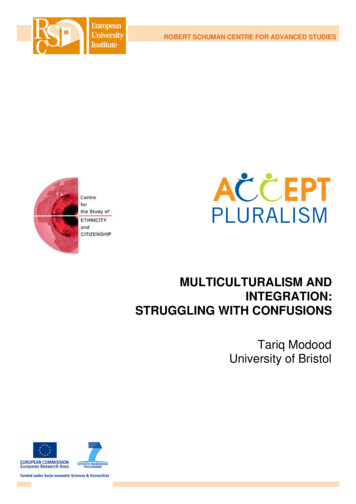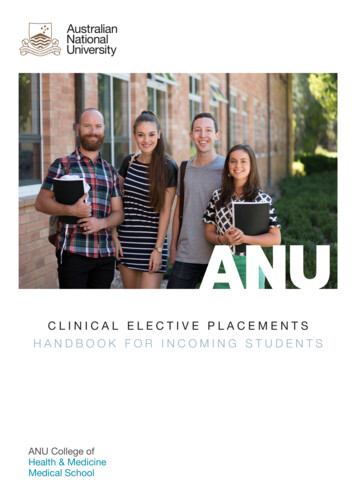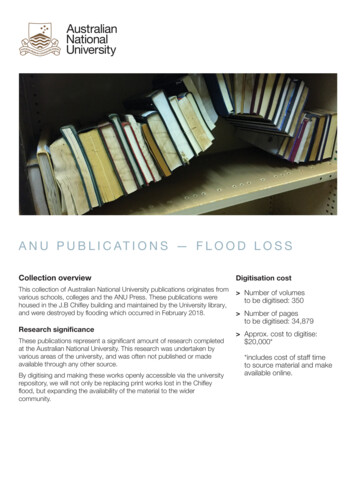
Transcription
Multiculturalism and IntegrationA Harmonious Relationship
Multiculturalism and IntegrationA Harmonious RelationshipEdited by the late Professor Michael Clyne and Dr James Jupp,for the Academy of the Social Sciences in Australia.THE AUSTRALIAN NATIONAL UNIVERSITYE PRESS
E PRESSPublished by ANU E PressThe Australian National UniversityCanberra ACT 0200, AustraliaEmail: anuepress@anu.edu.auThis title is also available online at: http://epress.anu.edu.auNational Library of AustraliaCataloguing-in-Publication entryAuthor:Michael Clyne and Dr James JuppTitle:Multiculturalism and integration : a harmonious relationship / edited byMichael Clyne and James Jupp, for the Academy of the Social Sciences inAustralia.ISBN:9781921862144 (pbk.) 9781921862151 (eBook)Notes:Includes bibliographical references and index.Subjects:Multiculturalism--Australia.Other Authors/Contributors:Clyne, Michael, 1939-2010.Jupp, James, 1932Academy of the Social Sciences in Australia.Dewey Number: 305.8All rights reserved. No part of this publication may be reproduced, stored in a retrieval systemor transmitted in any form or by any means, electronic, mechanical, photocopying or otherwise,without the prior permission of the publisher.Cover design and layout by ANU E PressThis edition 2011 ANU E Press
ContentsContributors . . . . . . . . . . . . . . . . . . . . . . . . . . . . . . . . . . . . . .viiAcknowledgements . . . . . . . . . . . . . . . . . . . . . . . . . . . . . . . . . ixAbstract . . . . . . . . . . . . . . . . . . . . . . . . . . . . . . . . . . . . . . . . . xiIntroduction . . . . . . . . . . . . . . . . . . . . . . . . . . . . . . . . . . . . . xiiiJames Jupp and Michael ClyneChapter 1: Changing Spatial Patterns of Immigrant Settlement . . . 1Graeme Hugo . . . . . . . . . . . . . . . . . . . . . . . . . . . . . . . . . .Chapter 2: Politics, Public Policy and Multiculturalism . . . . . . . . 41James JuppChapter 3: Multilingualism, Multiculturalism and Integration . . . . 53Michael ClyneChapter 4: Multicultural Integration in Political Theory . . . . . . . . 73Geoffrey Brahm LeveyChapter 5: Attitudes to Multiculturalism and Cultural Diversity . . 89Andrew MarkusChapter 6: Intermarriage, Integration and Multiculturalism:A Demographic Perspective . . . . . . . . . . . . . . . . . 101Siew-Ean KhooChapter 7: The Cost of Fluency . . . . . . . . . . . . . . . . . . . . . . 121Kim KirsnerChapter 8: Religion and Integration in a Multifaith Society . . . . 135James JuppChapter 9: The Incorporation of Australian Youthin a Multicultural and Transnational World . . . . . . . 151Christine Inglisv
Chapter 10: Dynamics of the Integration/MulticulturalConnection . . . . . . . . . . . . . . . . . . . . . . . . . . . . 179Reg AppleyardEpilogue: A Multicultural Future . . . . . . . . . . . . . . . . . . . . . . 191Michael Clyne and James JuppBibliography. . . . . . . . . . . . . . . . . . . . . . . . . . . . . . . . . . 199Index . . . . . . . . . . . . . . . . . . . . . . . . . . . . . . . . . . . . . . . . . 221vi
ContributorsEmeritus Professor Reg Appleyard AM, FASSA, Senior Research Fellow inEconomic History, University of Western Australia.(The Late) Professor Michael Clyne AM, FASSA, FAHA was a ProfessorialFellow in the Research Unit for Multilingualism at the University of Melbourne.Professor Clyne died during 2010 after his work on this book was completed.The book was largely his idea and it is dedicated to him as an outstanding andinternationally renowned scholar.Professor Graeme Hugo, FASSA, ARC Australian Professorial Fellow, Professorof Geography, University of Adelaide.Dr Christine Inglis, Honorary Associate Professor and Director of theMulticultural and Migration Research Centre, University of Sydney.Dr James Jupp AM, FASSA, Centre for Immigration and Multicultural Studies,Australian National University.Dr Siew-Ean Khoo, Senior Fellow, Australian Demographic and Social ResearchInstitute, Australian National University.Professor Kim Kirsner FASSA, Centre for Experimental and RegenerativeNeuroscience, University of Western Australia.Dr Geoffrey Levey, Senior Lecturer in Politics, University of New South Wales.Professor Andrew Markus FASSA, Director of the Australian Centre for theStudy of Jewish Civilisation, Monash University.vii
AcknowledgementsThis volume is dedicated to the memory of three distinguished pioneers in thestudy of ethnic diversity in Australia:Professor Michael Clyne (1939 – 2010) (Monash University)Professor Jerzy Zubrzycki (1920 – 2009) (Australian National University)Dr Charles Price (1920 – 2009) (Australian National University)And to the founder of Australian demographic studies:Professor Mick Borrie OBE, CBE (1913 – 2000) (Australian National University).This research was funded by the Australian Research Council through theLearned Academies Special Projects scheme (LASP).ix
AbstractMulticulturalism is a public policy adopted by all Australian governments, withvarying enthusiasm, since 1978. It has always been controversial and is currentlyfacing new challenges, especially in the growth of a Muslim community inAustralia. However, it has been defined and refined over more than thirty yearsas a method of settling a wide variety of immigrants from non-English speakingbackgrounds and has been relatively successful.Multiculturalism has always been seen as a function of the Commonwealth andhas not concerned itself with Indigenous affairs. It has normally been seen as aconcern of the Immigration Department and has been less interested in secondand subsequent generations of immigrant parentage, who now form a substantialpart of the population. Together with the overseas-born, they constitute 40 percent of the population, although a substantial number are of English-speakingdescent.This study draws on a variety of academic disciplines and results from an ARCLearned Academies grant awarded to the Academy of the Social Sciences inAustralia, which has managed the business side. The disciplines representedhere are Linguistics, Political Science, Sociology, Political Philosophy andDemography, rather than the central concern with economic factors whichdominates official thinking.The object is to inquire into precisely what is meant in practice by such termsas multiculturalism, integration, national identity and assimilation. The focusis not simply on the migrant generation in its early years but on long-standingsocial attributes such as language and religion. Academic studies of the longterm impacts of a diverse migration policy have been neglected in Australiacompared with the situation in Europe and North America. While this may bedue to the less acute problems here, it remains true that much more needs to bedone to illuminate the ongoing issues. This work is intended to start a debatewithin the formal disciplines but also to suggest directions and issues whichhave so far been inadequately surveyed by academics and policy makers. To thisend a group of academics known to each other for some time has come togetherto discuss the importance and impact of their disciplines on this important areaof public concern.JJMGCxi
IntroductionJames Jupp and Michael ClyneIt is often argued that Australian multiculturalism as a public policy hasnever been explained. This is quite untrue, but it remains true that changesof emphasis between governments of different persuasions have created aconfusing impression. Different usages of the term in various European andNorth American democracies have added to this confusion. However, Australiahas good claims, along with Canada, of having developed and implemented acoherent set of policies over a period of almost forty years. A range of publicand private institutions has taken part in this process. What is still lackingis a widespread understanding of the ethnic, cultural and linguistic changeswhich have occurred in Australia during this period. Partly this reflects thefact that multicultural interactions are largely confined to metropolitan areas (inwhich the majority of Australians live), a few provincial cities, and irrigationand mining districts. They have only marginally impacted on the provincial andrural districts on which so much of the ‘myths’ of Australia continue to rest. Theyhave also been resisted by many established politicians, bureaucrats, academicsand business leaders who still conceptualise Australia as an homogenous anduniform society, as it largely was in the era in which they grew up.A diverse worldMulticulturalism is a term which has been used and disputed for four decadesin various democracies in Europe, North America and Australasia. It refersessentially to political systems based on liberal democratic principles. Therehave been many other systems in many parts of the world which recognizeethnic variety – the Russian Federation, India and former Yugoslavia beingexamples. However these have usually dealt with ethnic variety by federation,where each ethnic community has its own political institutions and geographicalboundaries. Multiculturalism as practised in Australia, Canada or Sweden, isessentially intended for mixed populations created by international migration.These are typically found in major cities living together but having differentorigins, religions, languages and other aspects of distinct cultures.The typical multicultural situation is one where there is a dominant ethnicity,usually based on early settlers, although these might also contain Indigenous orearlier communities such as Roma, Welsh, Aborigines or Maori. The dominantethnicity has typically seen itself as a ‘founding nation’ even when othershave been established in the modern territory for much longer but in smallerxiii
Multiculturalism and Integrationnumbers. This is obviously the situation in Australia, where ‘Europeans’ (ineffect from the British Isles) have only formed the majority since the 1830s, orover most of North America below the Arctic Circle.The ‘founding nation’ through its control of the instruments of government,education and the economy, has historically defined the characteristics of thenation as a whole, including its language, its religion, its ‘way of life’ and itssense of superiority. However mass immigration by others may well challengethis status or, alternatively, be expected to conform to its values, institutionsand practices. In liberal democracies, of course, the domination of the ‘foundingnation’ is justified in terms of voting majorities. These determine the socialinstitutions, practices and attitudes. Others may be excluded from the franchise,as were many Afro-Americans in the southern US, Jews in Nazi Germany orAfricans in South Africa.The need for multiculturalism was not strongly felt in most liberal democraciesuntil after the Second World War. Prior to that, and especially after the FirstWorld War, empires began to break up into component parts based on theWilsonian notion of self-determination. This was enshrined in the principlesof the League of Nations and, after 1945, the United Nations. The result to datehas been the creation of two hundred sovereign states, each one with the legaland constitutional status of all other nation states. Yet even these units are notethnically uniform. On the contrary, there are very few states which do notcontain ethnic variety within them. As population migration continues despiteborders and legal obstacles, this variety also increases. States which broke awayfrom others in the past now face the danger of lesser ethnic groups breakingaway from them. The most obvious recent case has been in Yugoslavia. Thealternative to such a breakdown has been to devolve power to ethnic groupson a quasi-federal basis. In recent years once unitary states such as the UnitedKingdom and Spain have chosen this solution. India is the largest state in theworld to devolve authority on a linguistic basis, creating new states where thereis a political demand for them. It works well except in the state of Kashmir,where the Muslim religion is more important than language.Well-established states do not favour total defection and may fight to prevent it,as the UK has done in Northern Ireland. States which are ethnically diverse butdo not have distinct concentrations of minorities on which a viable unit couldbe built, may turn to multiculturalism as a solution. But this is not universal andmany liberal democracies, including the United States, Germany, France andDenmark, have specifically rejected this approach, even while adopting someof its practices. In Australia there are no distinctive population concentrationslarge and developed enough to form the base of a viable state. All componentstates and territories of the Commonwealth have a mixed population with AngloAustralians dominant. In the United States and Canada there are states whichxiv
Introductionare ethnically distinct. That is not the basis on which their original boundarieswere drawn, except for the newly created Nunavut area of northern Canada.Indigenous North Americans (First Nations) all have claims on territories andexercise some authority within them. But apart from Canada these do notconstitute self-government.The multicultural political solution to ethnic diversity is, then, not universal.But some aspects of multiculturalism are found in many societies whichhave not adopted it as a national policy; in particular, many cities with largeimmigrant populations have adopted welfare services, interpreting systems,school curricula, grants to organisations and religions, and festivals. Lookingat the policies of cities and provinces in Germany, France or the United Stateswill show close resemblances to those in Australia, Sweden, Canada or Britain.Indeed, while Britain is not officially multicultural at the national level, itslocal government authorities are legally obliged to foster policies and practicesthat cater for their multi-ethnic populations. The opposite trend may also betrue, where second rank authorities impose restrictions, as with the Englishonly policy adopted by many American States. In Switzerland, a multiculturalsociety with power largely devolved to cantons, the building of minarets atmosques was forbidden by a majority referendum, and many other issues arealso decided this way. Apart from local variety, multiculturalism is usuallysustained by legal provisions protecting minorities from discrimination. Theseare endorsed in detail by the European Union and the government of the UnitedStates, mainly in response to the civil rights campaign of the 1960s.While Australia insists on preserving English as its only official languageand rigorously subscribes to the equal treatment of all religions (s.116 of theConstitution) this is no longer very common in the rest of the world. Mostnation states recognise or give official status to a variety of languages, with thelargest choice being in India and South Africa. Others giving multiple officialchoices include the majority of recently colonial societies, with English andFrench a common official or second language throughout Africa, English in thePacific and Russian in central Asia. Second languages, usually on a regional basis,are recognised legally in the United Kingdom, Switzerland, Finland, Belgium,Spain, Russia, Canada, Peru, Bolivia, Sri Lanka, New Zealand, Singaporeand Malaysia, among others. The outstanding exceptions, the United States,Australia, Germany, France, Greece, Turkey and Pakistan, for example, are byno means monolingual. Australian public policy has funded English languageclasses for immigrants since 1947, has a state owned multilingual broadcastingsystem and issues public notices in sixteen languages. Even in the United States,in response to court rulings, voting information is published in Chinese andother languages where there is a significant number of voters using a languageother than English.xv
Multiculturalism and IntegrationState support for religion is also quite common. It ranges from the officialProtestant churches of England, Scotland, Germany and the Scandinavian states,to public funding for religious schools. This has reached a level of catering forone third of pupils in Australia and is not limited to Christian schools, as inmany other states.What is multiculturalism?The whole world is multicultural and many states – democratic or authoritarian–make some provision for cultural variety and the needs of minorities. Despitethis, multiculturalism under that name has been highly controversial andis currently said to be in retreat, even where it has been officially adopted.In Australia national public policy has moved away from ‘multiculturalism’to ‘integration’ while most State and Territory governments continue theirprogrammes unchanged. In Europe there has been a positive ‘backlash’1. Thesechanges have been reflected in party politics in most liberal democracies.Multiculturalism as an ideology and a public policy has most enthusiasticallybeen copied by the liberal and social democratic side of party politics – theCanadian Liberals, the Swedish and other Scandinavian social democrats, BritishLabour, the Australian and New Zealand labour parties, and the Greens. Mostof these have recently suffered electoral defeats or a reduction in their supportand cohesion. In Europe democratic socialist governments are now confined toNorway, Spain, Portugal and Greece. In Australia, New Zealand, Switzerland,France, Denmark, the Netherlands, Britain and even Sweden, conservativeparties critical of multiculturalism have recently been victorious. Even moreimportantly, extreme parties have made considerable progress although theyhave usually been excluded from government. This has not been the case inAustralia, where One Nation reached its peak in the 1990s and then disappeared.However some of its attitudes were taken over by the Liberal-National Coalitionunder John Howard (1996-2007).Partisan and electoral support for multiculturalism has weakened in most liberaldemocracies and has always been contested in the United States. It has neverbeen officially endorsed in Germany or France. There are several reasons for thisresistance: the collision between liberal democracy and Islamic fundamentalism asevidenced by terrorist attacks in various cities in the new century;1 Vertovec, S and Wessendorf, S (eds) (2010). The Multiculturalism Backlash, Routledge, London.xvi
Introduction resistance to continuing, increasing and frequently uncontrolled immigrationfrom poorer societies, especially from Africa, the Middle East, South Asiaand Latin America; economic and social problems which social democracy has failed to solve; poverty and social dislocation in some concentrations of immigrants andrefugees; a perception that the distinct civilisations and cultures built on a Europeanbasis are losing their pre-eminence; rapidly changing social structures and belief systems which creates anxiety.The significance of these varies from time to time and place to place. Religiousobjections to Islam are less powerful in secular societies, including Australia,than in the United States where there are strong movements to reassert the‘Judeo-Christian’ inheritance. Fears of terrorism are probably less significantwhere there has been none within the society, as in Australia, New Zealand,Switzerland or Scandinavia. Extreme anti-immigrant parties vary in strengthconsiderably and this is not related to economic conditions; the concept ofnational culture may be more rigorously adhered to in some societies (suchas Denmark or France) than in others (such as Australia or other immigrantsocieties). However judgement of some of these influences is often subjectiveand influenced by partisan loyalties. Eruptions of anti-immigrant feeling andattacks on multiculturalism are not always predictable. The sudden rise andequally rapid fall of One Nation in Australia is but one example. The rapid shiftto extreme positions in the Netherlands, prompted by individual acts of terror,was even more spectacular and longer lasting.What, then, is the multiculturalism which has provoked such opposition andled to such major political shifts? The classic Australian definition is containedin the Galbally report of 1978 (Migrant Services and Programs). While thiswas presented to the Prime Minister, Australian multiculturalism has alwaysbeen concerned with immigrants and has remained within the Immigrationportfolio for most of the past thirty years. This is not the case in Canada, wherepolicy rests with the Department of Canadian Heritage, or in most other stateswhich have adopted the term. In Europe it is common for immigration to beallocated to the Department of Justice (or equivalent). In Britain immigrationand multiculturalism were the responsibility of the Home Office throughthe Commission for Racial Equality, but were later transferred to the LocalGovernment Department as the Commission for Integration and Cohesion.The Australian definition of 1978 stressed the delivery of services to nonEnglish-speaking background migrants (NESB):xvii
Multiculturalism and Integration migrants have the right to maintain their culture and racial identity provided that ethnic identity is not stressed at the expense of society atlarge; the development of a multicultural society will benefit all Australians; the most significant and appropriate bodies to be involved in the preservationand fostering of cultures are the ethnic organisations themselves.Four guiding principles were laid down2:1. all members of our society must have equal opportunity to realise their fullpotential and must have equal access to programs and services;2. every person should be able to maintain his or her culture without prejudiceor disadvantage3. needs of migrants should, in general be met by programs and servicesavailable to the whole community but special services and programs arenecessary at present;4. services and programs should be designed and operated in full consultationwith clients, and self-help should be encouraged as much as possible with aview to helping migrants to become self-reliant quickly.The Canadian Multiculturalism Act of 19883 concentrated on four areas:1. combating racism and discrimination;2. ensuring that the Government of Canada represents the country’s diversepopulation;3. promoting shared citizenship –making sure that all Canadians feel part ofCanada;4. cross-cultural understanding.These two classic definitions of multiculturalism start from different premisesand move in different directions. Canada has been a bicultural (Anglophone/Francophone) society for three centuries. Australia had just ended an immigrationpolicy (White Australia) which preserved its monocultural character. Mostof its NESB migrants had come as Displaced Persons in need of welfare andlanguage services. The new intake from southern Europe was starting toorganise and demand greater services from a more sympathetic state. Whilethis was also happening in Canada, the long-term perspective there was thatcultural differences would endure. The Australian expectation was that they23xviiiGalbally, F (chair) (1978). Migrant Services and Programs, AGPS, Canberra: 4.Annual Report on the Operation of the Canadian Multiculturalism Act; Ottawa, 2002 Cat no. Ci95-1/2002.
Introductionwould fade but should be endorsed while they lasted. Both agreed that theirsocieties were moving from a monocultural (Australia) or bicultural (Canada)form to a multicultural one. At this pioneering stage Canadians were morewilling to accept this than were many Australians. But in both societies politicalleadership on these issues was bipartisan. Neither had much experience withnon-Europeans or with non-Christians until the 1980s.Aims and content of the volumeAgainst this background, this volume represents the first substantial results ofan interdisciplinary project conducted by the Academy of the Social Sciences inAustralia, with funding from the Australian Research Council under its learnedAcademies Special Projects scheme (LASP)4. The Academy took a leading rolein the early days of multicultural studies in the 1970s, but this has not beenevenly developed by the appropriate academic disciplines. This project, entitledMulticulturalism and Integration – a Harmonious Relationship, brings togetherscholars from the disciplines of demography, geography, history, linguistics,political philosophy, political science, psychology and sociology. They are basedat seven universities. It goes beyond the usual descriptive work on immigrationto look at issues such as population distribution, language usage and adaptation,public attitudes, integration and incorporation and demographic change.The background to the project is the current concern with social cohesion andnational integration. In most Western democracies there has been an increasein academic work on terrorism, Islam, immigration and refugees. Governmentshave often sponsored these studies, but they are fragmented and of varyingquality. Cultural diversity was once a very important interdisciplinary area inAustralia which contributed to policy formation and also to Australia’s statusin the field. This work has tended to be run down in recent years. The objectof the Project is to encourage its revitalisation so that policy is informed bylocal research and collaborative work. Much research emanates from NorthAmerica or the European Union and is not always relevant to Australia althoughit has been consulted. Most chapters are supported by substantial statisticaland diagrammatic information. This study is concerned with Australianmulticulturalism, rather than with the many alternative formulations andpolicies adopted in other democracies.This volume is dedicated to the memory of two eminent scholars who werepioneers in the field of migrant and multicultural studies. They paved the wayfor understanding the kind of Australia we have today.4Project 10 LS0800003.xix
Multiculturalism and IntegrationThe ANU demographer Dr Charles Price, AM (1920-2009) is well known forstudies of people of different backgrounds. These indicate both a more diverseand a more integrated society. He also wrote many studies on Germans, Italians,Greeks, Maltese, ‘Slavs’, Jews, Chinese and other groups at a time when suchstudies were rare. For several years in the 1950s and 1960s he publishedbibliographies and digests on Australian immigration, keeping a tab on the stateof a small but growing field. He was often the first port of call for graduatestudents, new scholars and visiting academics, providing excellent advice andnetworking nationally and internationally.The ANU sociologist and demographer, Professor Jerzy (George) Zubrzycki,AM (1920-2009), is often credited with being the ‘father’ of Australianmulticulturalism. His rejection of the assimilationist and monocultural attitudes,which greeted those arriving in the post-war migration boom, reflected his ownexperiences as a new arrival from Poland by way of Britain and the LondonSchool of Economics. He embodied and demonstrated the importance of the linkbetween research and policy. His role on the Australian Ethnic Affairs Council,the Immigration Advisory Council, and especially the National MulticulturalAffairs Council was essential, as most of these were still dominated by nativeborn Australians. He was a central figure in the research-focused AustralianInstitute of Multicultural Affairs between 1979 and 1986 and served on thecommittee which developed the latest multicultural agenda in 1999.Professor Zubrzycki saw Australia as offering the world a harmonious modelfor migrant integration, in which cultural and economic rights were respected.His published work included studies of Polish migration to Australia andelsewhere. His two classics were Settlers of the Latrobe Valley (1964) and TheForeign Language Press in Australia (1967, with Miriam Gilson).Exact contemporaries, Price and Zubrzycki had quite different backgrounds.But both saw the multicultural future of Australia more clearly than many oftheir colleagues at the time. Both left a major legacy of academic work withoutparallel in the early post-war decades.All the contributors focus on the complementarity of multiculturalism andintegration in Australia. This needs to be done because of the attempts bythe Howard government (1996-2007) to wipe the multicultural slate clean bysubstituting integration, as though it were opposite and superior. In practicethe two go together. The debate centred on ‘values’ was a transparent attemptto isolate Muslims as ‘unAustralian’, which was both unfair and not sensiblein terms of maintaining social harmony. Certainly Muslims have a longer roadto travel than, say, Irish or Dutch migrants. James Jupp examines the religiousaspect of multiculturalism, which has become increasingly important in the lastdecade.xx
IntroductionMigrants become ‘acculturated’ in the sense of learning English (which manyfrom Asia know already), by enjoying the delights of an affluent society, perhapsby calling their children Wayne and Kylie. But they speak their own languagein the home, attend their own churches, mosques and temples, prefer soccer torugby league or Australian rules, and keep an ‘ethnic’ kitchen. They can alsomaintain links with the original homeland much more easily than in the past,through frequent and relatively cheap flights and mobile phones. Many evenmaintain a resting place for visits to their home villages and relatives. In a majorstudy of locations, Graeme Hugo sets the scene.The book fol
ix Acknowledgements This volume is dedicated to the memory of three distinguished pioneers in the study of ethnic diversity in Australia: Professor Michael Clyne (1939 - 2010) (Monash University) Professor Jerzy Zubrzycki (1920 - 2009) (Australian National University) Dr Charles Price (1920 - 2009) (Australian National University) And to the founder of Australian demographic studies:










